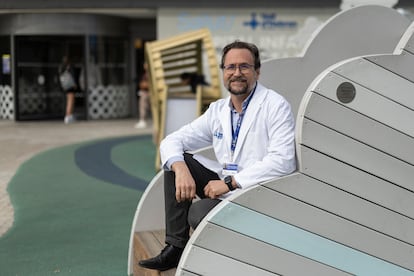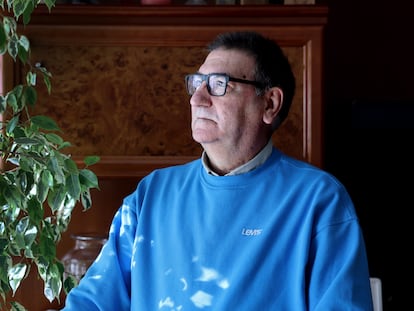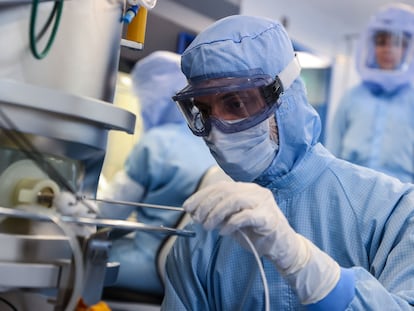Lucas Moreno, oncologist: ‘Pharmaceutical companies do not show much interest in pediatric cancer’
The doctor points out that 80% of children with cancer are cured, but many have to live with the consequences

Thursday, February 15 is International Childhood Cancer Day. The disease has little to do with adult tumors, but in both cases there are cells that go crazy and multiply uncontrollably. However, they are very different diseases: their origin is different and so is their frequency. “Luckily,” says pediatric oncologist Lucas Moreno, childhood cancer affects few patients. “There is one cancer in children for every 200 in adults. It is a minority disease or, rather, a group of diseases because there is not just one cancer, there are 40 different types,” explains the doctor, who is head of the Pediatric Oncology and Hematology service at the Vall d’Hebron Hospital in Barcelona.
Moreno admits that the low frequency of cases complicates research and progress is made very slowly. The oncologist has just published a study in the Journal of Clinical Oncology in which his team proves that an innovative combination of drugs shows a slight improvement in children with a very aggressive neuroblastoma. When there is no cure, the key is to buy time.
Question. Experts say that if we improve our lifestyle, adults can prevent 40% of tumors. Can we do likewise with childhood tumors?
Answer. Children’s cancers are totally different, and environmental factors do not influence them. They are developmental alterations. Some cells that do not function very well are left over from embryonic development, and at some point they begin to grow.
Q. Is childhood cancer still a great unknown?
A. Its low frequency makes it more difficult to research, find the resources, and gather the data that is needed. In the last decade, there has been a very significant advance in the knowledge of what happens in tumors. We have not found the causes for why they are produced, but we have identified what happens for them to grow. However, there are still not many examples of success with using new drugs as has happened in adult oncology.
Q. Is the process of creating cancer the same as in adults?
A. What happens is crazy cell proliferation. What triggers it, we still don’t know, but we do know how it starts. In adult cancers, environmental factors cause mutations to accumulate, cells break down, and when they reach a certain level, that is when they start to grow. In children’s tumors, there are few mutations. What we see most often are chromosomal alterations, things on a larger scale, and mutations in the epigenome, which is not so much in the DNA sequence, but in how it folds and how they come together.
Q. Can these alterations be reversed or anticipated?
A. Not yet because those environmental factors are not known. There are also no population screening programs because they are tumors that grow very quickly. One area in which we are growing is in the 10% of cancers that are related to a genetic trait that makes it easier to develop a tumor. When these genes are identified, the entire family’s health is investigated so that, if a cancer appears, it is found more clearly.
Q. What is the usual prognosis?
A. The most common cancers in children and adolescents are leukemias, lymphomas, and brain tumors. In cancer in general, survival rates are good: more than 80% are cured. But of that 80%, many have to live with consequences from the treatment they received, and that affects their quality of life.
Q. What kind of consequences?
A. For example, a patient who has a bone tumor and who has to get a hip or knee replacement: living your entire life with a prosthetic joint creates a series of limitations. Another example: receiving radiotherapy to the brain when you are young can affect your neurodevelopment, how you learn, and your performance at school. And it can cause another tumor 10 or 20 years later in a different part of the body. There are patients who undergo cancer treatment and have absolutely no after-effects and return to their normal lives with no problems. But there are others who have that risk throughout their lives.
Q. You have explained the big picture, but what about a more nuanced view?
A. Those with the best results are leukemias, lymphomas, and some kidney tumors, which have a cure rate of more than 90%. Now, the most important thing with these cancers is to refine the treatment as much as possible to have fewer consequences. On the other hand, there are other examples, such as brain tumors like high-grade gliomas; and solid tumors, such as some sarcomas and neuroblastomas — especially when there are metastases — in which we do not cure even half of the patients. And there the challenge is to look for new drugs to improve these results.

Q. You have just had positive results in the treatment of neuroblastomas with a study that combines chemotherapy and a monoclonal antibody.
A. This is a clinical trial for high-risk neuroblastoma, which is the one that has metastases, when patients have relapsed. What we’re doing is trying all the new things that are available, and we’re trying a monoclonal antibody that prevents the vessels that bring food to the tumor from growing. What we have published is that this has improved the response, the patients’ tumors are reduced, or they are tumor-free for longer. Less than 10% of neuroblastoma patients who relapse survive. It is a very stubborn disease.
Q. You said in that study that the response rate was 26% with the new therapeutic approach, compared to 18% with chemotherapy alone. How has this data been interpreted?
A. This is such a resistant disease and for which so many things have been tried so many times, that any small improvement allows children to live longer without the disease recurring. If this works a little and we add another combination to this in the next trial and this also makes an improvement, we can gradually build on that improvement.
Q. Where are the great difficulties in finding treatments that will reverse the disease?
A. One of them is the biology of the tumors because they are very aggressive and do not respond to anything. The fact that they occur in few patients makes it more difficult to test the drugs. Also, cancer in children is an area that pharmaceutical companies are not particularly interested in due to its relative rarity. Now, there are incentives and obligations for companies that work in pediatric cancer, and there are more and more that do, but there is still not a large volume like in adults.
Q. In the last decade there has been a revolution with the introduction of new drugs for adults. What is the situation with the therapeutic arsenal for children?
A. This great explosion of precision oncology and immunotherapy in adults has not been reflected in pediatric cancer. We still don’t have such a large number of drugs available. Many have been tried and do not work, and others have not yet arrived. Despite all those approved for adults, we can count on one hand the new drugs that are available for children.
Q. The great revolution of recent years has been CAR-T [a cellular therapy that consists of extracting T lymphocytes from the patient, modifying them in the laboratory with genetic engineering and returning them to the patient so that they can better combat the tumor].
A. The great revolution until the previous decade was to combine and make the most of the treatment we already have (chemotherapy, radiotherapy, and surgery). CAR-Ts have come to fill specific gaps in specific diseases where they have indeed changed the paradigm. Today there is only one CAR-T available for leukemias in a specific situation and there the results have changed. But there is no CAR-T for solid tumors or for other hematological tumors and such. They have not yet changed the paradigm of pediatric oncology on the whole, but in specific situations where they do have a very important role.
Q. What future therapies are in the pipeline?
A. There has been a great movement in the CAR-Ts being manufactured that have value for pediatric cancer because they go against targets that these tumors have. It’s still early, but we have a lot of hope because there are going to be many clinical trials in different applications for brain tumors, for neuroblastomas, and for leukemias in other situations. And with all that, we do think that there will be a revolution.
Q. Where is gene therapy?
A. Gene therapy has not yet reached childhood cancer, but it has reached some hematological diseases that can result in childhood cancer. When a disease is caused because a gene has stopped working, if there is a way to replace some cells with others in which that gene is fixed, it also fixes your disease. In hematological diseases, it will result in those patients having fewer cancers, and it will avoid collateral damage.
Q. What are the big questions that remain to be answered in childhood cancer?
A. A very important one is to know what makes tumors resistant. Because we do have first-line treatments for almost all tumors, but there are many that learn to become resistant and the cells escape. And we still don’t know how to prevent them from becoming resistant or blocking the mechanisms to prevent them from becoming metastatic and reappearing.
Sign up for our weekly newsletter to get more English-language news coverage from EL PAÍS USA Edition
Tu suscripción se está usando en otro dispositivo
¿Quieres añadir otro usuario a tu suscripción?
Si continúas leyendo en este dispositivo, no se podrá leer en el otro.
FlechaTu suscripción se está usando en otro dispositivo y solo puedes acceder a EL PAÍS desde un dispositivo a la vez.
Si quieres compartir tu cuenta, cambia tu suscripción a la modalidad Premium, así podrás añadir otro usuario. Cada uno accederá con su propia cuenta de email, lo que os permitirá personalizar vuestra experiencia en EL PAÍS.
¿Tienes una suscripción de empresa? Accede aquí para contratar más cuentas.
En el caso de no saber quién está usando tu cuenta, te recomendamos cambiar tu contraseña aquí.
Si decides continuar compartiendo tu cuenta, este mensaje se mostrará en tu dispositivo y en el de la otra persona que está usando tu cuenta de forma indefinida, afectando a tu experiencia de lectura. Puedes consultar aquí los términos y condiciones de la suscripción digital.











































